The Intel 9th Gen Review: Core i9-9900K, Core i7-9700K and Core i5-9600K Tested
by Ian Cutress on October 19, 2018 9:00 AM EST- Posted in
- CPUs
- Intel
- Coffee Lake
- 14++
- Core 9th Gen
- Core-S
- i9-9900K
- i7-9700K
- i5-9600K
CPU Performance: Web and Legacy Tests
While more the focus of low-end and small form factor systems, web-based benchmarks are notoriously difficult to standardize. Modern web browsers are frequently updated, with no recourse to disable those updates, and as such there is difficulty in keeping a common platform. The fast paced nature of browser development means that version numbers (and performance) can change from week to week. Despite this, web tests are often a good measure of user experience: a lot of what most office work is today revolves around web applications, particularly email and office apps, but also interfaces and development environments. Our web tests include some of the industry standard tests, as well as a few popular but older tests.
We have also included our legacy benchmarks in this section, representing a stack of older code for popular benchmarks.
All of our benchmark results can also be found in our benchmark engine, Bench.
WebXPRT 3: Modern Real-World Web Tasks, including AI
The company behind the XPRT test suites, Principled Technologies, has recently released the latest web-test, and rather than attach a year to the name have just called it ‘3’. This latest test (as we started the suite) has built upon and developed the ethos of previous tests: user interaction, office compute, graph generation, list sorting, HTML5, image manipulation, and even goes as far as some AI testing.
For our benchmark, we run the standard test which goes through the benchmark list seven times and provides a final result. We run this standard test four times, and take an average.
Users can access the WebXPRT test at http://principledtechnologies.com/benchmarkxprt/webxprt/
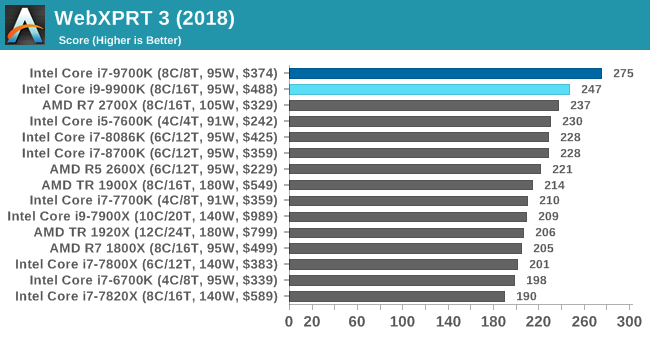
WebXPRT 2015: HTML5 and Javascript Web UX Testing
The older version of WebXPRT is the 2015 edition, which focuses on a slightly different set of web technologies and frameworks that are in use today. This is still a relevant test, especially for users interacting with not-the-latest web applications in the market, of which there are a lot. Web framework development is often very quick but with high turnover, meaning that frameworks are quickly developed, built-upon, used, and then developers move on to the next, and adjusting an application to a new framework is a difficult arduous task, especially with rapid development cycles. This leaves a lot of applications as ‘fixed-in-time’, and relevant to user experience for many years.
Similar to WebXPRT3, the main benchmark is a sectional run repeated seven times, with a final score. We repeat the whole thing four times, and average those final scores.

Speedometer 2: JavaScript Frameworks
Our newest web test is Speedometer 2, which is a accrued test over a series of javascript frameworks to do three simple things: built a list, enable each item in the list, and remove the list. All the frameworks implement the same visual cues, but obviously apply them from different coding angles.
Our test goes through the list of frameworks, and produces a final score indicative of ‘rpm’, one of the benchmarks internal metrics. We report this final score.
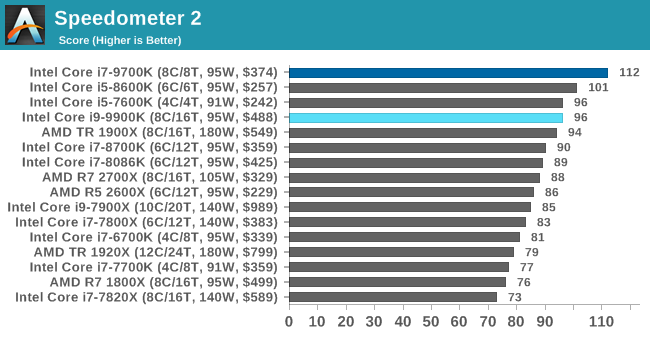
Google Octane 2.0: Core Web Compute
A popular web test for several years, but now no longer being updated, is Octane, developed by Google. Version 2.0 of the test performs the best part of two-dozen compute related tasks, such as regular expressions, cryptography, ray tracing, emulation, and Navier-Stokes physics calculations.
The test gives each sub-test a score and produces a geometric mean of the set as a final result. We run the full benchmark four times, and average the final results.
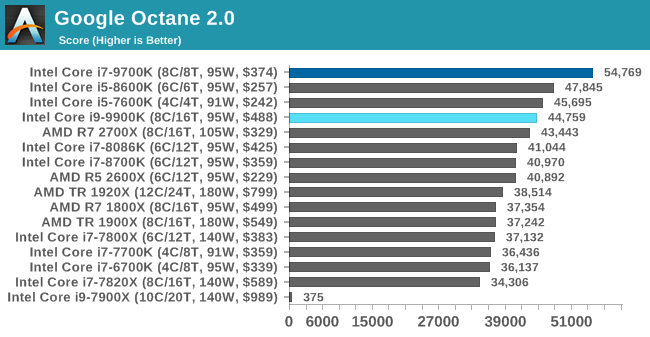
Mozilla Kraken 1.1: Core Web Compute
Even older than Octane is Kraken, this time developed by Mozilla. This is an older test that does similar computational mechanics, such as audio processing or image filtering. Kraken seems to produce a highly variable result depending on the browser version, as it is a test that is keenly optimized for.
The main benchmark runs through each of the sub-tests ten times and produces an average time to completion for each loop, given in milliseconds. We run the full benchmark four times and take an average of the time taken.
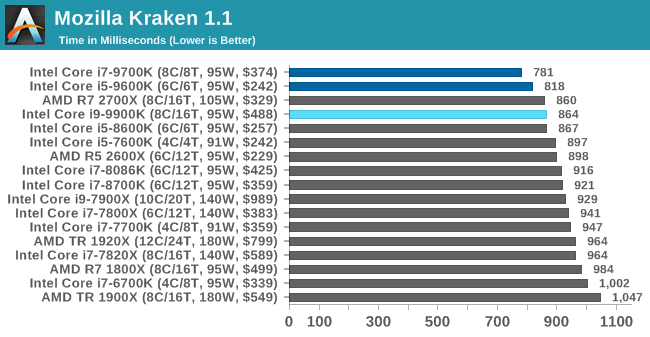
3DPM v1: Naïve Code Variant of 3DPM v2.1
The first legacy test in the suite is the first version of our 3DPM benchmark. This is the ultimate naïve version of the code, as if it was written by scientist with no knowledge of how computer hardware, compilers, or optimization works (which in fact, it was at the start). This represents a large body of scientific simulation out in the wild, where getting the answer is more important than it being fast (getting a result in 4 days is acceptable if it’s correct, rather than sending someone away for a year to learn to code and getting the result in 5 minutes).
In this version, the only real optimization was in the compiler flags (-O2, -fp:fast), compiling it in release mode, and enabling OpenMP in the main compute loops. The loops were not configured for function size, and one of the key slowdowns is false sharing in the cache. It also has long dependency chains based on the random number generation, which leads to relatively poor performance on specific compute microarchitectures.
3DPM v1 can be downloaded with our 3DPM v2 code here: 3DPMv2.1.rar (13.0 MB)
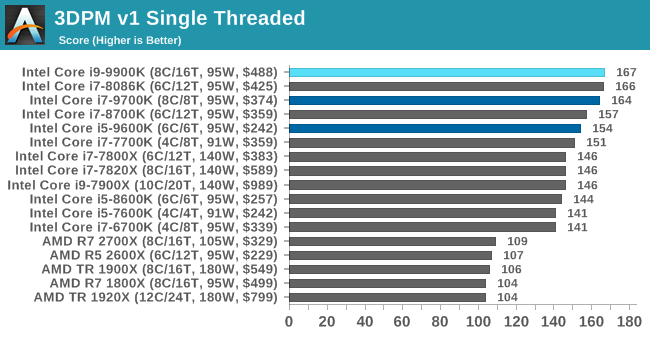
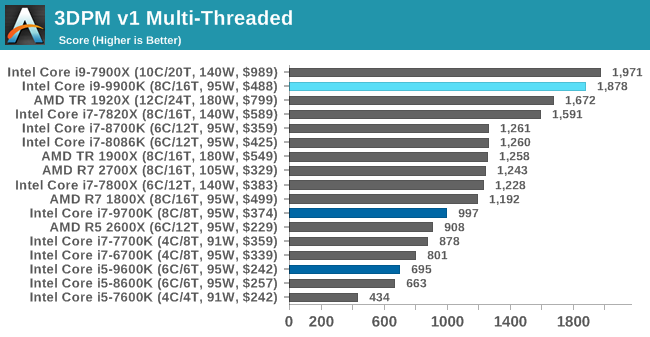
x264 HD 3.0: Older Transcode Test
This transcoding test is super old, and was used by Anand back in the day of Pentium 4 and Athlon II processors. Here a standardized 720p video is transcoded with a two-pass conversion, with the benchmark showing the frames-per-second of each pass. This benchmark is single-threaded, and between some micro-architectures we seem to actually hit an instructions-per-clock wall.
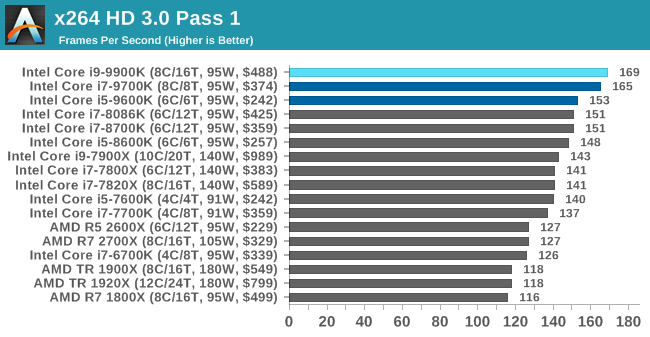
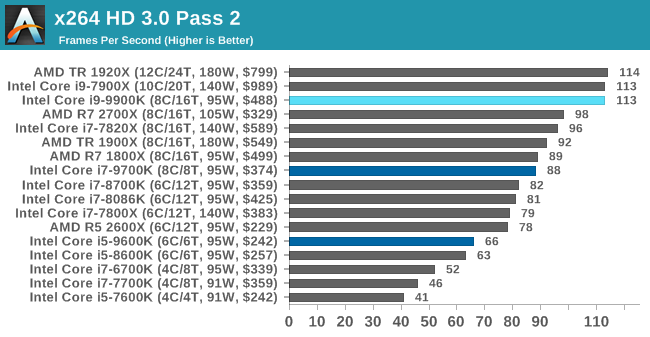










274 Comments
View All Comments
eastcoast_pete - Sunday, October 21, 2018 - link
Yes; unfortunately, that's a major exception, and annoying to somebody like me who'd actually recommend AMD otherwise. I really hope that AMD improves it's AVX/AVX2 implementation and makes it truly 256 bit wide. If I remember correctly, the lag of Ryzen chips in 256 bit AVX vs. Intel is due to AMD using a 2 x 128 bit implementation (workaround, really), which is just nowhere near as fast as real 256 bit AVX. So, I hope that AMD gives their next Ryzen generation full 256 bit AVX, not the 2 x 128 bit workaround.mapesdhs - Sunday, October 21, 2018 - link
It's actually worse than that with pro apps. Even if AMD hugely improved their AVX, it won't help as much as it could so long as apps like Premiere remain so poorly coded. AE even has plugins that are still single-threaded from more than a decade ago. There are also several CAD apps that only use a single core. I once sold a 5GHz 2700K system to an engineering company for use with Majix, it absolutely blew the socks off their far more expensive XEON system (another largely single-threaded app, though not entirely IIRC).Makes me wonder what they're teaching sw engineering students these days; parallel coding and design concepts (hw and sw) was a large part of the comp sci stuff I did 25 years ago. Has it fallen out of favour because there aren't skilled lectures to teach it? Or students don't like tackling the hard stuff? Bot of both? Some of it was certainly difficult to grasp at first, but even back then there was a lot of emphasis on multi-threaded systems, or systems that consisted of multiple separate functional units governed by some kind of management engine (not unlike a modern game I suppose), at the time coding emphasis being on derivatives of C++. It's bizarre that after so long, Premiere inparticular is still so inefficient, ditto AE. One wonders if companies like Adobe simply rely on improving hw trends to provide customers with performance gains, instead of improving the code, though this would fly in the face of their claim a couple of years ago that they would spend a whole year focusing on improving performance since that's what users wanted more than anything else (I remember the survey results being discussed on creativcow).
eastcoast_pete - Sunday, October 21, 2018 - link
Fully agree! Part of the problem is that the re-coding single-thread routines that could really benefit from parallel/multi-thread execution costs the Adobes of this world money, especially if one wants it done right. However, I believe that the biggest reason why so many programs, in full or in part, are solidly stuck in the last century is that their customers simply don't know what they are missing out on. Once volume licensees start asking their software supplier's sales engineers (i.e. sales people) "Yes, nice new interface. But, does this version now fully support multithreaded execution, and, if not, why not?", Adobe and others will give this the priority it should have had all along.repoman27 - Friday, October 19, 2018 - link
USB Type-C ports don't necessarily require a re-timer or re-driver (especially if they’re only using Gen 1 5 Gbit/s signaling), but they do require a USB Type-C Port Controller.The function of that chip is rather different though. Its job is to utilize the CC pins to perform device attach / detach detection, plug orientation detection, establish the initial power and data roles, and advertise available USB Type-C current levels. The port controller also generally includes a high-speed mux to steer the SuperSpeed signals to whichever pins are being used depending on the plug orientation. Referring to a USB Type-C Port Controller as a re-driver is both inaccurate and confusing to readers.
willis936 - Friday, October 19, 2018 - link
Holy damn that's a lot of juice. 220W? That's 60 watts more than a 14x3GHz core IVB E5.They had better top charts with that kind of power draw. I have serious reservations about believing two DDR4 memory channels is enough to feed 8x5GHz cores. I would be interested in a study of memory scaling on this chip specifically, since it's the corner case for the question "Is two memory channels enough in 2018?".
DominionSeraph - Friday, October 19, 2018 - link
This chip would be faster in everything than a 14 core IVB E5, while being over 50% faster in single-threaded tasks.Also, Intel is VERY generous with voltage in turbo. Note the 9700K at stock takes 156W in Blender for a time of 305, but when they dialed it in at 1.025V at 4.6GHz it took 87W for an improved time of 301, and they don't hit the stock wattage until they've hit 5.2GHz. When they get the 9900K scores up I expect that 220W number to be cut nearly in half by a proper voltage setting.
3dGfx - Friday, October 19, 2018 - link
How can you claim 9900k is the best when you never tested the HEDT parts in gaming? Making such claims really makes anandtech look bad. I hope you fix this oversight so skyX can be compared properly to 9900K and the skyX refresh parts!!! -- There was supposed to be a part2 to the i9-7980XE review and it never happened, so gaming benchmarks were never done, and i9-7940X and i9-7920X weren't tested either. HEDT is a gaming platform since it has no ECC support and isn't marketed as a workstation platform. Curious that intel says the 8-core part is now "the best" and you just go along with that without testing their flagship HEDT in games.DannyH246 - Friday, October 19, 2018 - link
If you want an unbiased review go here...https://www.extremetech.com/computing/279165-intel...
Anandtech is a joke. Has been for years. Everyone knows it.
TEAMSWITCHER - Friday, October 19, 2018 - link
Thanks... but no thanks. Why did you even come here? Just to post this? WEAK!Arbie - Friday, October 19, 2018 - link
What a stupid remark. And BTW Extremetech's conclusion is practically the same as AT's. The bias here is yours.